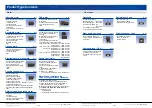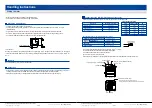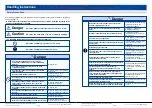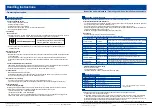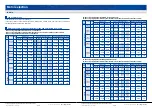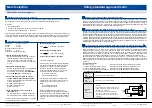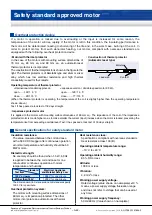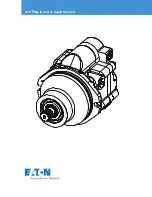
– A-48 –
Panasonic Corporation Electromechanical Control Business Division
industrial.panasonic.com/ac/e/
©
Panasonic Corporation 2018
AQCTB02E 201806-E
– A-49 –
Panasonic Corporation Electromechanical Control Business Division
industrial.panasonic.com/ac/e/
©
Panasonic Corporation 2018
AQCTB02E 201806-E
Motor selection
Hoisting application
Determination of
driving mechanism
Calculation of
motor speed and load
Check of
required specifications
Selection of
motor model
Temporary selection of
the motor
Final determination of
the motor and gear head
• SI units
• Gravitational system of units
Motor
D
W
Band wheel
Motor
W
D
F
W
D
Motor
Motor
Flywheel
Band wheel
F
W
μ
P
T = D ·
W (N·m)
D
: Diameter of drum
(m)
W
: Load
(N)
1
2
T = D ·
W (kgf·m)
D
: Diameter of drum
(m)
W
: Load
(kgf)
1
2
• SI units
• Gravitational system of units
T = ·
(N·m)
N
: Rotating speed
(r/min)
J
: Inertia
(kg·cm
2
)
t
: Time
(s)
J
9.55
x
10
4
N
t
T = ·
(kgf·m)
N
: Rotating speed
(r/min)
GD
2
: Flywheel effect
(kgf·cm
2
)
t
: Time
(s)
GD
2
3750000
N
t
• SI units
• Gravitational system of units
T = D
(
F
+
μW
g)
(N·m)
D
: Diameter of roll
(m)
W
: Mass of load
(kg)
g : Gravitational acceleration 9.8
(m/s
2
)
μ
: Friction coefficient
F
: External force
(N)
1
2
T = D
(
F
+
μW
)
(kgf·m)
D
: Diameter of roll
(m)
W
: Weight of load
(kgf)
μ
: Friction coefficient
F
: External force
(kgf)
1
2
• SI units
• Gravitational system of units
T = P
(
F
+
μW
g)
(N·m)
F
: External force
(N)
W
: Mass of load
(kg)
μ
: Friction coefficient of sliding
surfaces (approx. 0.05 to 0.2)
g : Gravitational acceleration 9.8
(m/s
2
)
P
: Lead of ball screw
(m)
1
2π
T = P
(
F
+
μW
)
(kgf·m)
F
: External force
(kgf)
W
: Weight of load
(kgf)
μ
: Friction coefficient of sliding
surfaces (approx. 0.05 to 0.2)
P
: Lead of ball screw
(m)
1
2π
• SI units
• Gravitational system of units
T = D · μW
g
(N·m)
D
: Diameter of drum
(m)
W
: Mass
(kg)
g : Gravitational acceleration 9.8
(m/s
2
)
μ
: Friction coefficient
1
2
T = D · μW (kgf·m)
D
: Diameter of drum
(m)
W
: Weight
(kgf)
μ
: Friction coefficient
1
2
First, determine the driving mechanism and its dimensions.
And then check the conditions required for the mechanism such as the
mass of the load and traveling speed.
Calculate the load torque, moment of inertia and speed which are
converted to those at the motor output shaft. Refer to page A-49 to A-58
for the rotation speed, load torque and moment of inertia of the load for
various mechanism.
Check the required specifications such as positioning accuracy, holding of
position, speed range, operating voltage and other environmental
resistances for the mechanism and the machine.
Select the most appropriate motor model to meet the required
specifications.
Select the motor and gear head based on the defined speed at the motor
shaft, load torque and moment of inertia of the load.
Make sure that the selected gear head and the motor combination meets
all of the required specifications including mechanical strength,
acceleration time and torque, then make a final determination.
Belt conveyor application
Horizontal travel on contact face
Ball screw drive
Flywheel application
Selecting procedure
Checking of load torque





